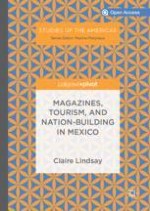Open Access 2019 | Open Access | Book

Magazines, Tourism, and Nation-Building in Mexico
Author: Dr. Claire Lindsay
Publisher: Springer International Publishing
Book Series : Studies of the Americas
Open Access 2019 | Open Access | Book

Author: Dr. Claire Lindsay
Publisher: Springer International Publishing
Book Series : Studies of the Americas
This open access book discusses the relationship between periodicals, tourism, and nation-building in Mexico. It enquires into how magazines, a staple form of the promotional apparatus of tourism since its inception, articulated an imaginative geography of Mexico at a time when that industry became a critical means of economic recovery and political stability after the Revolution. Notwithstanding their vogue, popularity, reach, and close affiliations to commerce and state over several decades, magazines have not received any sustained critical attention in the scholarship on that period. This book aims to redress that oversight. It argues that illustrated magazines like Mexican Folkways (1925–1937) and Mexico This Month (1955–1971) offer rich and compelling materials in that regard, not only as unique tools for interrogating the ramifications of tourism on the country’s reconstruction, but as autonomous objects of study that form a vital if complex part of Mexico’s visual culture.